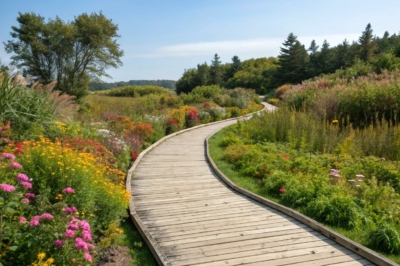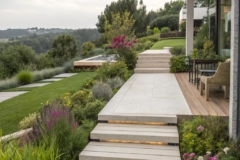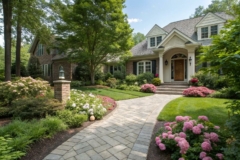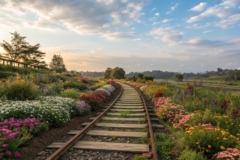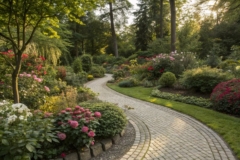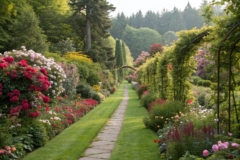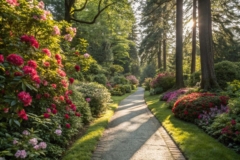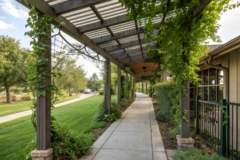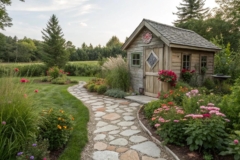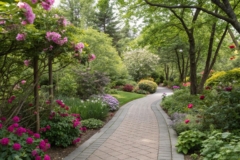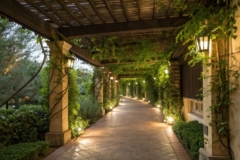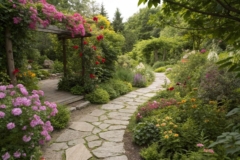1. Decorative Elements
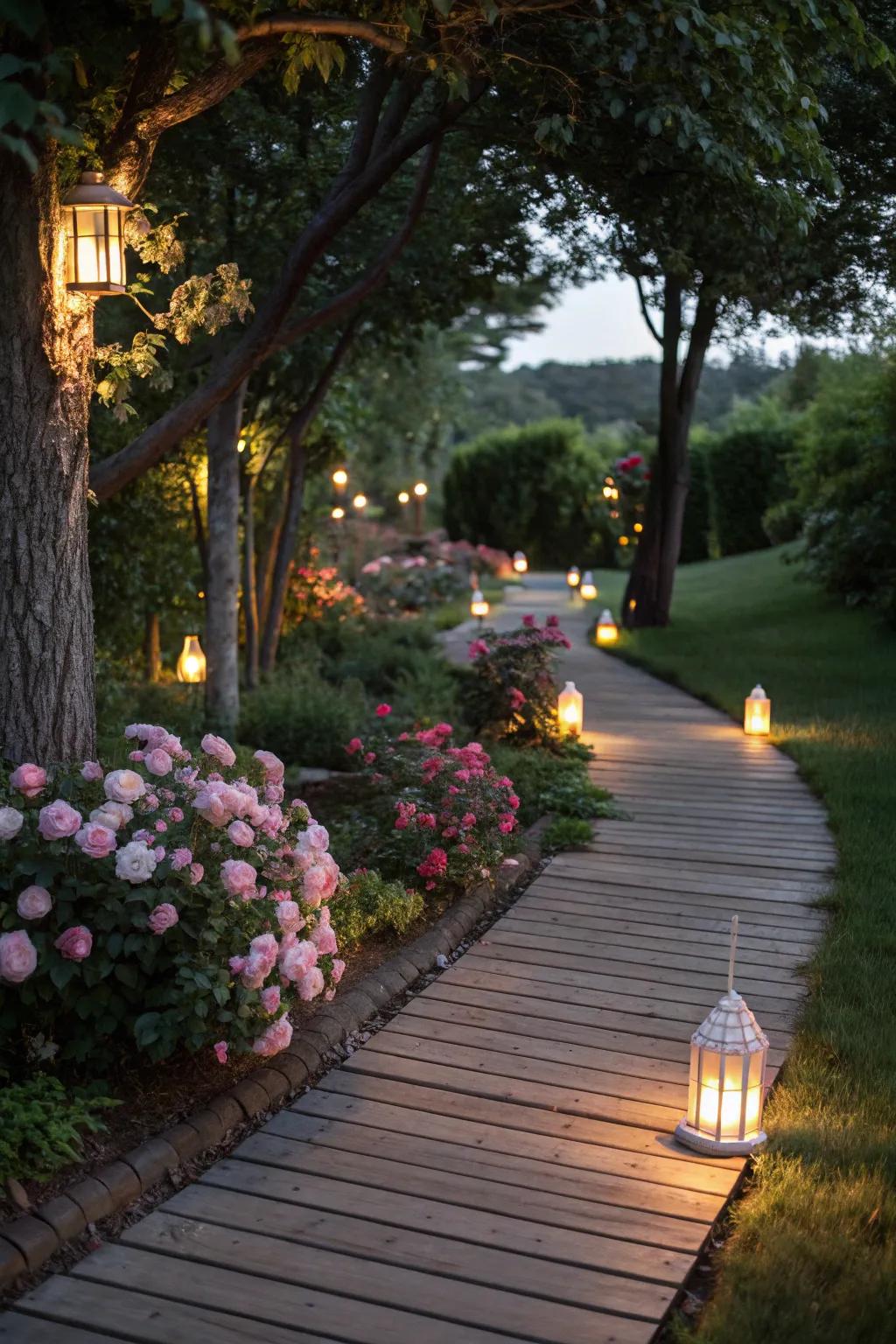
Combine timber with decorative elements like plants and garden lights to enhance your walkway’s charm. In my garden, subtle lighting along the timber path adds a magical touch at night.
A few suggestions:
- Solar Garden Pathway Lights: Illuminate your timber walkways with eco-friendly solar lights for charming nighttime appeal.
- Outdoor Lanterns: Add an enchanting glow to your path with decorative outdoor lanterns.
- Garden Edging Border: Define your garden pathways stylishly with durable and attractive garden edging.
2. Integration with Landscapes
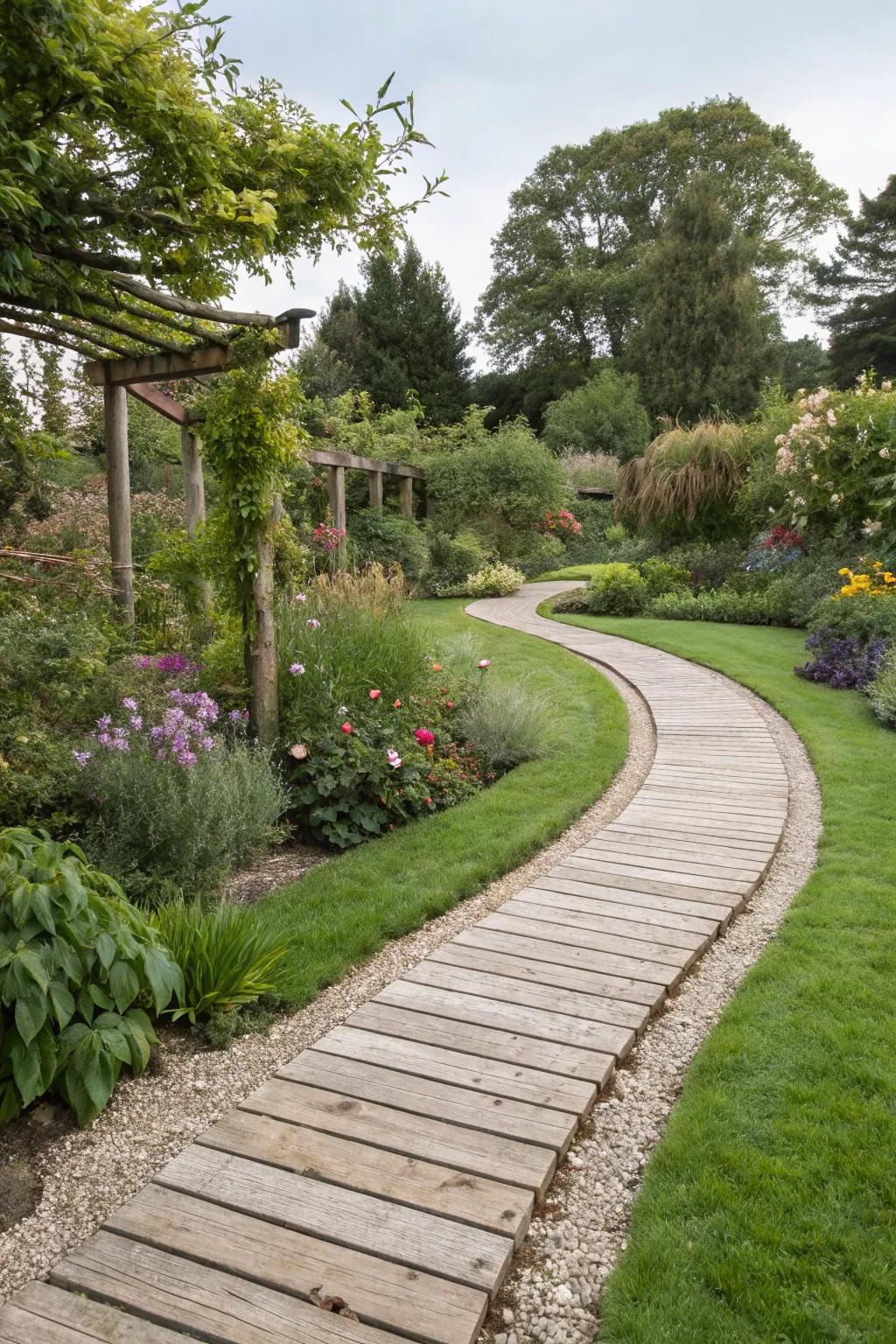
Achieve seamless integration by using timber walkways that blend with lawns or gravel. This approach in my garden ensures a smooth transition between different areas.
Might be a good match:
- Weather-Resistant Timber Walkway Panels: Enhance your garden’s elegance with durable timber panels that naturally blend with landscapes.
- Natural Garden Gravel: Create smooth transitions in your garden using natural gravel suitable for pathway borders.
- Wood Preservative and Sealant: Protect and prolong the life of your timber walkways with quality sealant treatment.
3. Variety in Materials and Finishes
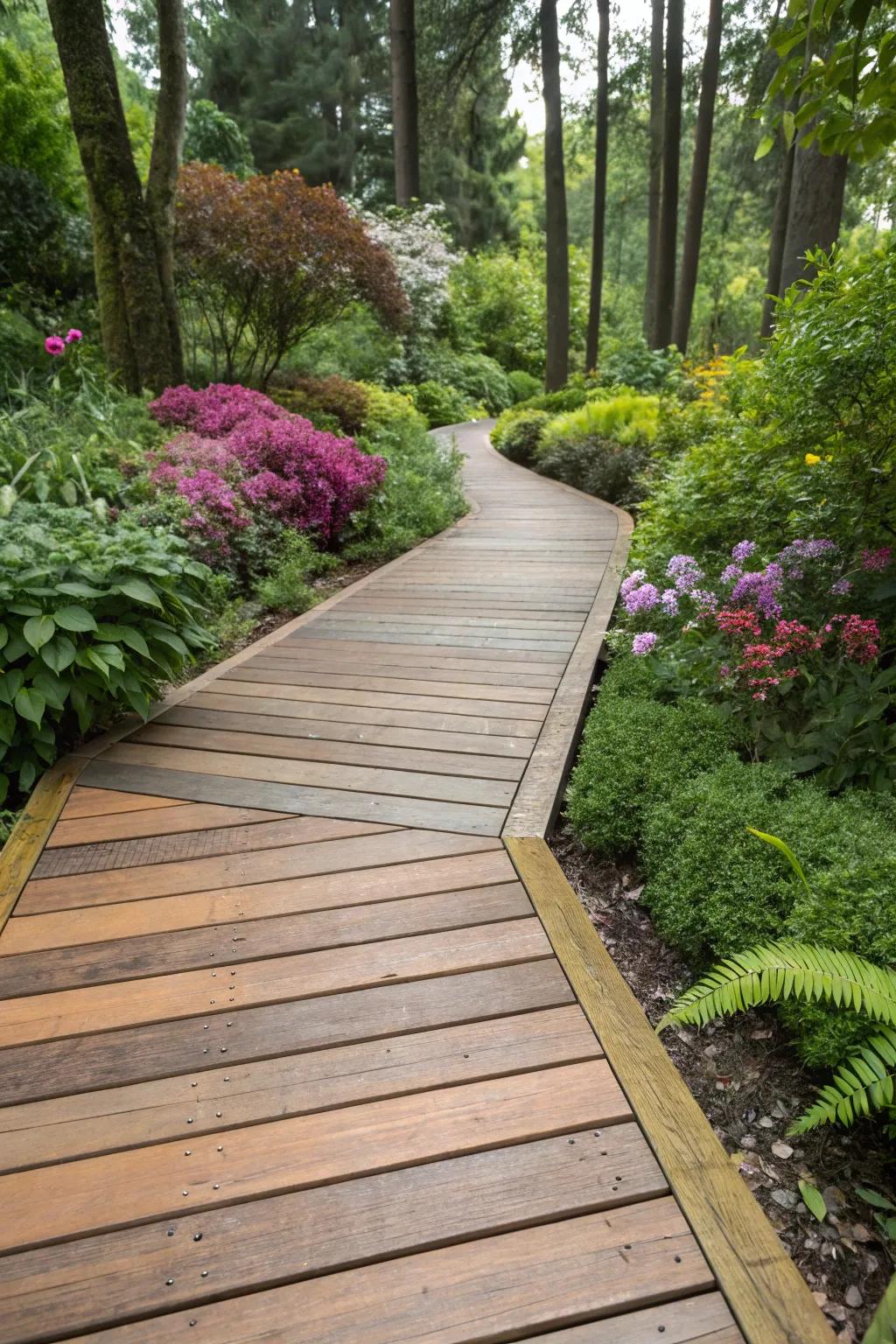
Experiment with different wood types and finishes for unique timber walkway designs. In my experience, a mix of polished and weathered wood adds depth to the garden.
Products that could assist:
- Weathered Timber Planks: Add rustic charm to your garden with these authentic weathered timber planks. Perfect for unique pathways.
- Polished Wooden Deck Boards: Enhance your walkway design with these polished wooden boards. Create sleek, modern garden paths.
- Wood Treatment Oil: Protect and beautify your wooden walkways with durable wood treatment oil. Perfect for lasting appeal.
4. Eco-Friendly Wooden Walkways
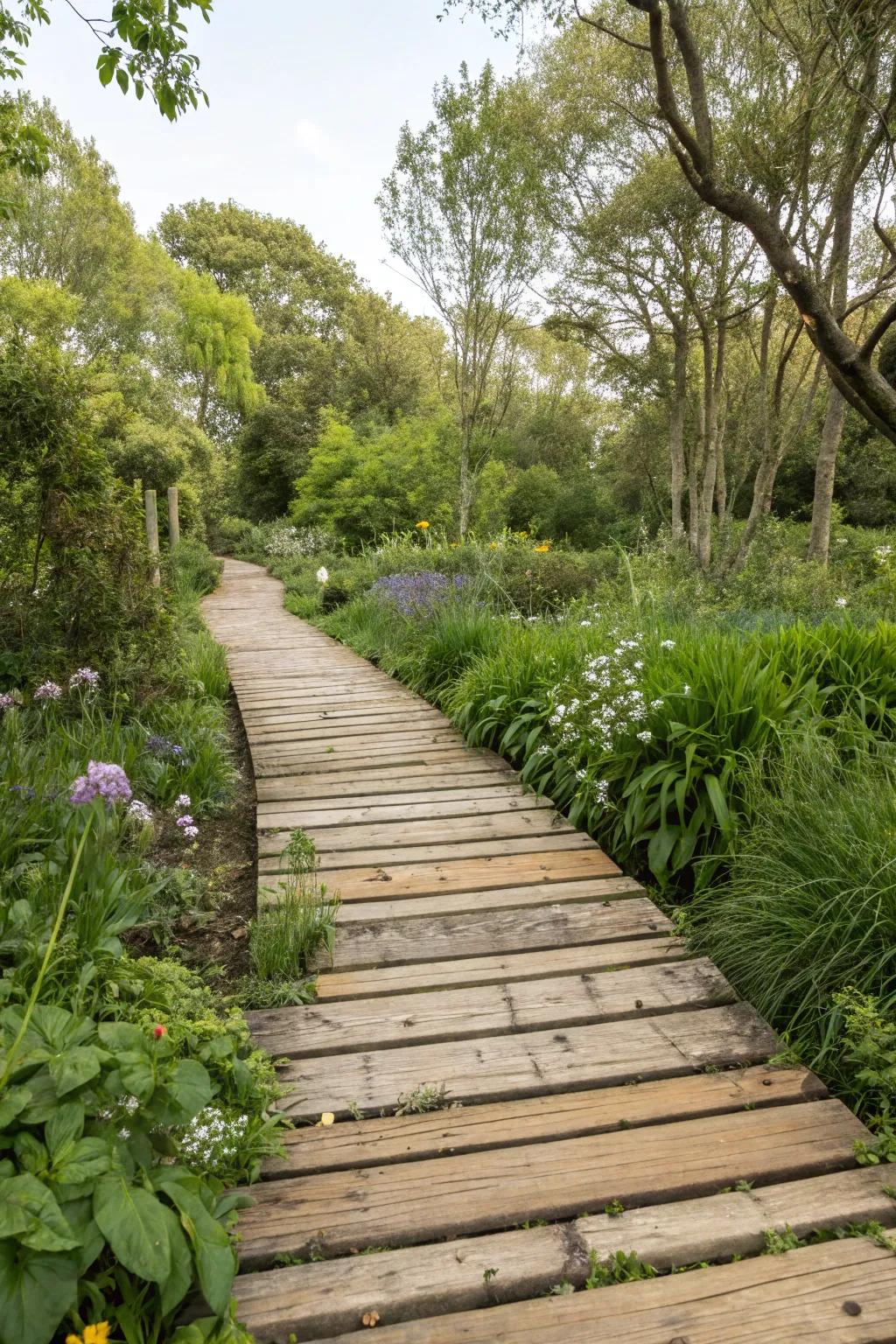
Opt for eco-friendly timber walkways made from reclaimed wood. In my garden, this sustainable choice enhances beauty while caring for the environment.
Try these:
- Reclaimed Wood Decking Tiles: Enhance your garden with easy-to-install, eco-friendly reclaimed wood decking tiles today.
- Natural Cedar Wood Planks: Choose natural cedar wood planks to create a beautiful, sustainable garden path effortlessly.
- Weather-Resistant Outdoor Wood Stain: Protect your wooden walkway with eco-friendly, weather-resistant outdoor wood stain now.
5. Artistic Wooden Pathways
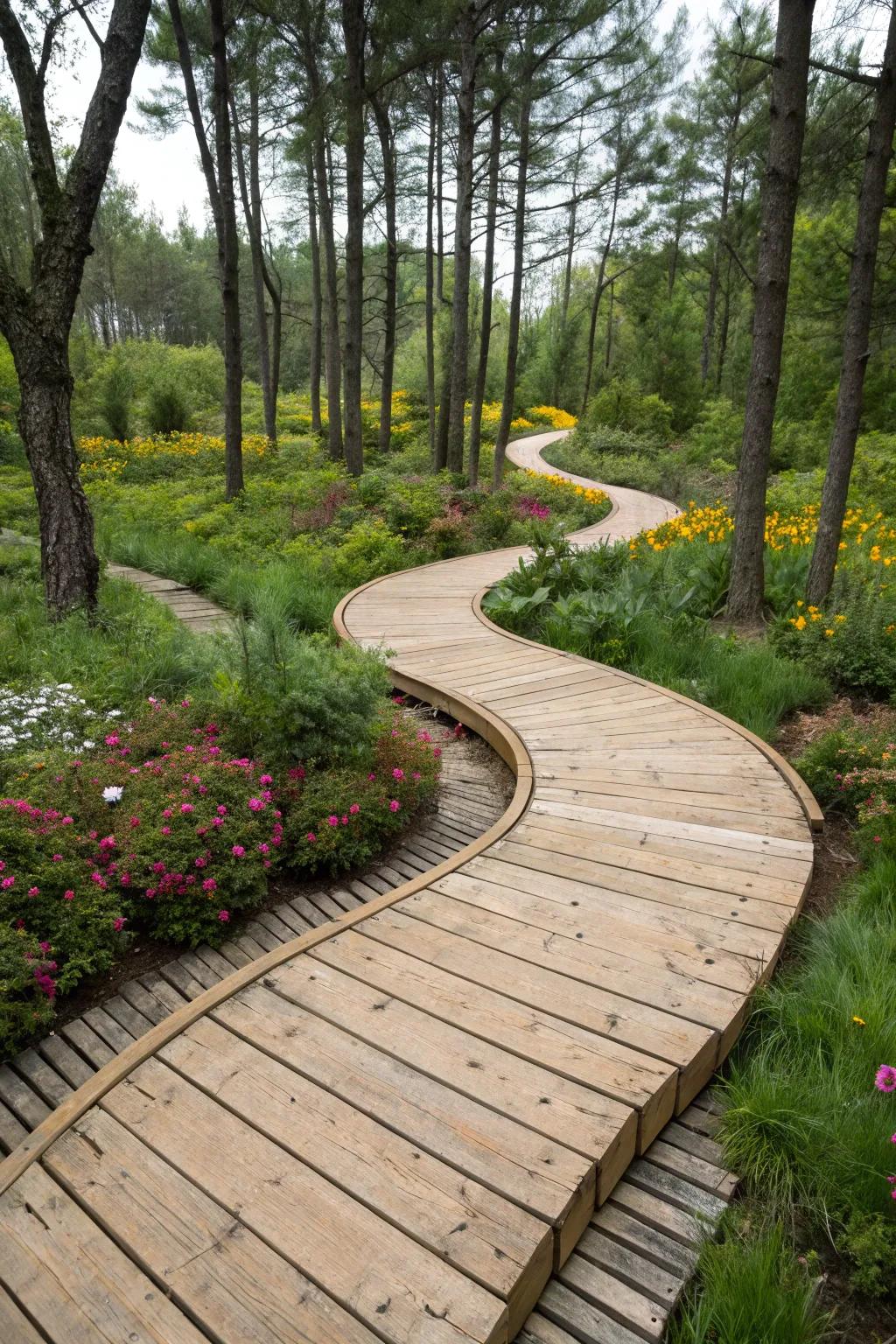
Unleash creativity with artistic timber pathways featuring unique designs. My garden’s spiral path adds a standout feature that’s both functional and beautiful.
These products might be useful:
- Interlocking Wooden Deck Tiles: Enhance your garden’s charm with easy-to-install interlocking deck tiles that merge elegance and function.
- Outdoor Wood Protector: Protect your wooden pathways from weathering with a durable, high-quality outdoor wood protector.
- Decorative Garden Edging: Define your garden pathways creatively with eye-catching and sturdy decorative garden edging solutions.
6. Zen Garden Wooden Pathways
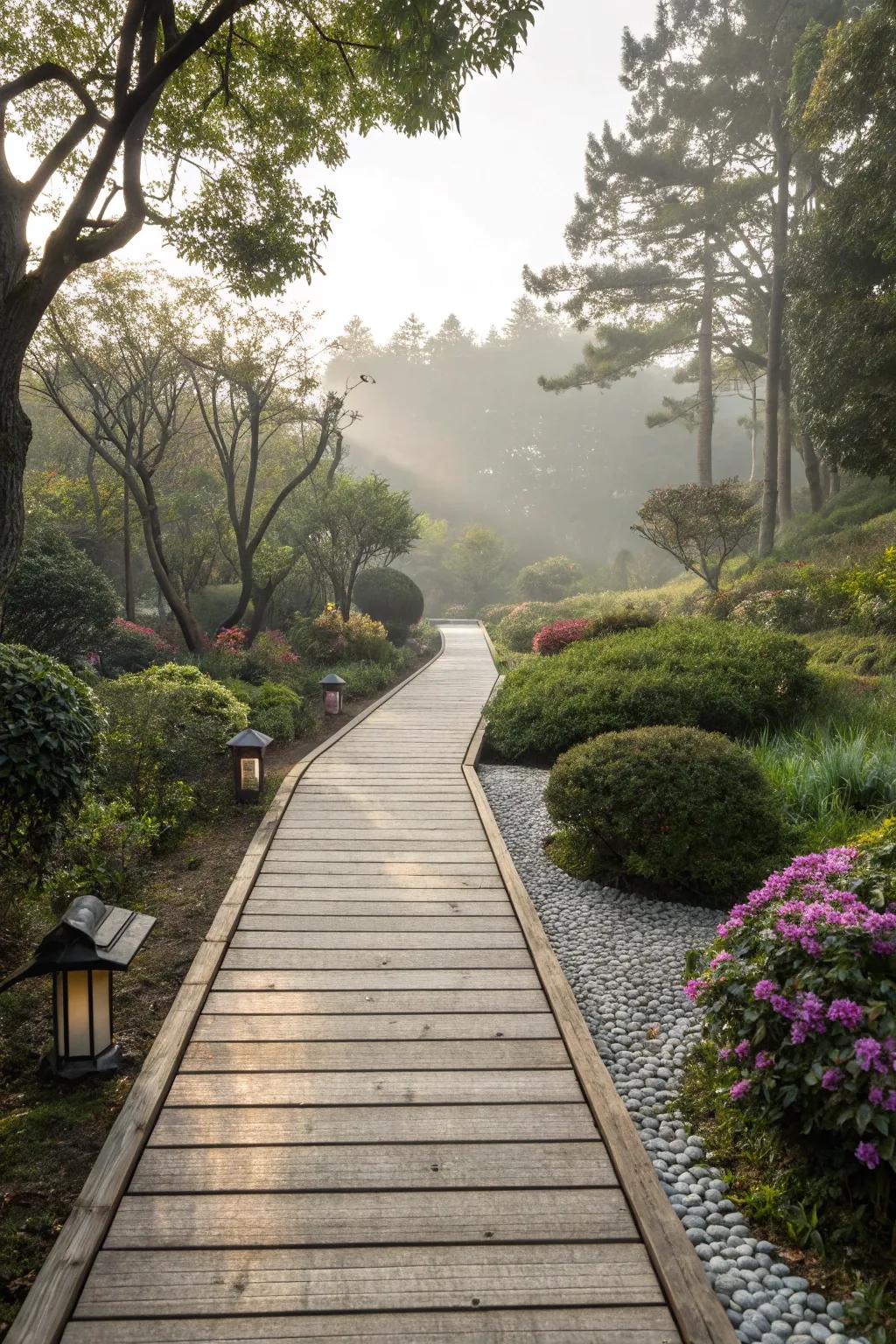
Create a serene retreat with Zen-inspired timber pathways. In my garden, this design encourages mindfulness and tranquility.
Useful items to consider:
- Outdoor Wooden Pathway Panels: Enhance your garden’s tranquility with natural wooden panels, fostering a serene and mindful experience.
- Japanese Garden Lanterns: Illuminate your Zen pathway with elegant lanterns, adding a touch of peace and beauty.
- Decorative River Pebbles: Accent your garden walkway with smooth river pebbles, perfect for a natural, calming touch.
7. Elevated Paths with Glass Railings
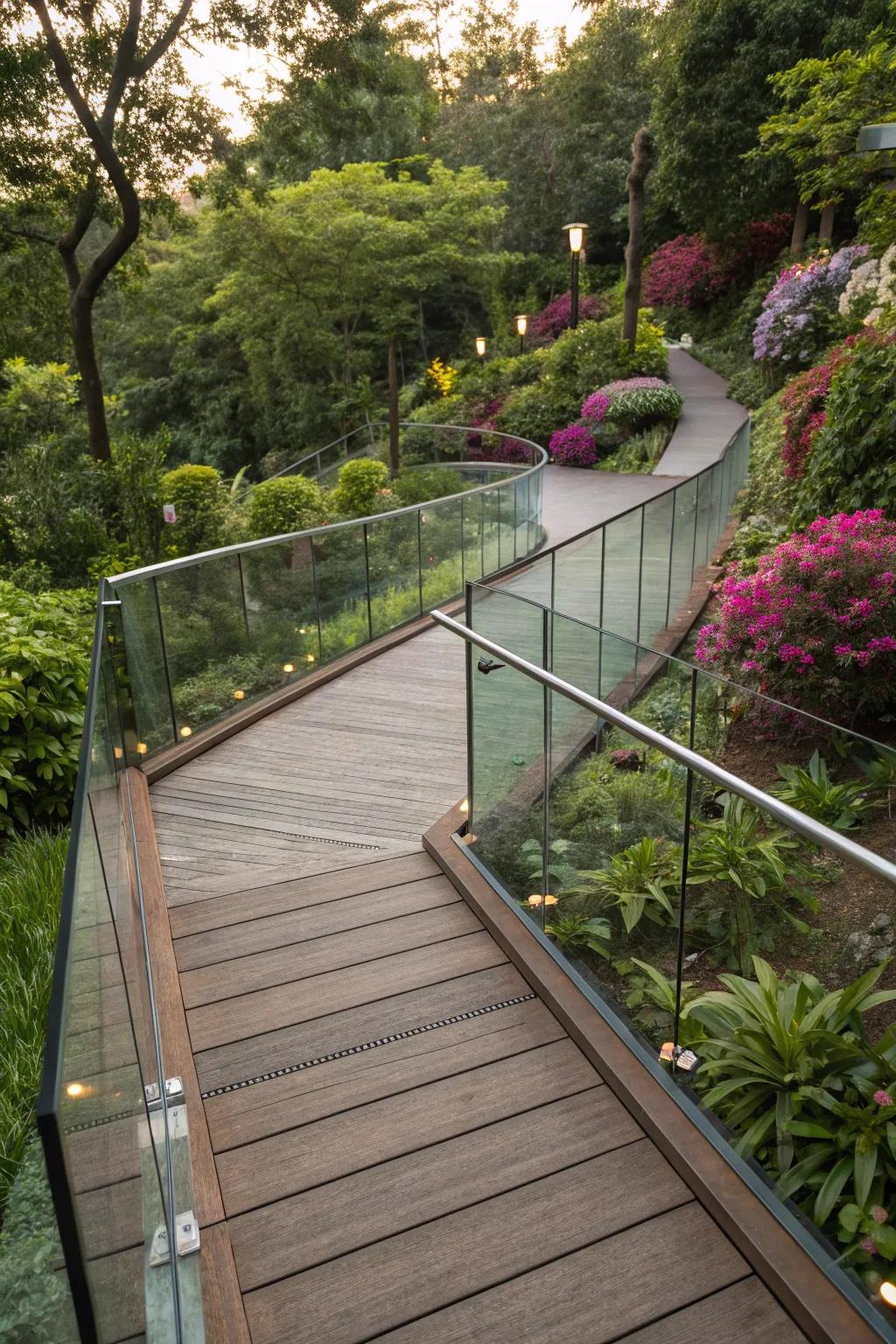
For a luxurious feel, consider elevated timber paths with glass railings. In my garden, this design provides unobstructed views and a touch of elegance.
Items that may come in handy:
- Timber Decking Boards: Upgrade your garden walkway with durable timber decking boards for a natural and elegant look.
- Glass Railing Kits: Enhance your elevated path with transparent glass railing kits for unobstructed views and safety.
- Solar Pathway Lights: Illuminate your timber walkway with eco-friendly solar pathway lights, adding elegance and visibility.
8. Geometric Wooden Pathways
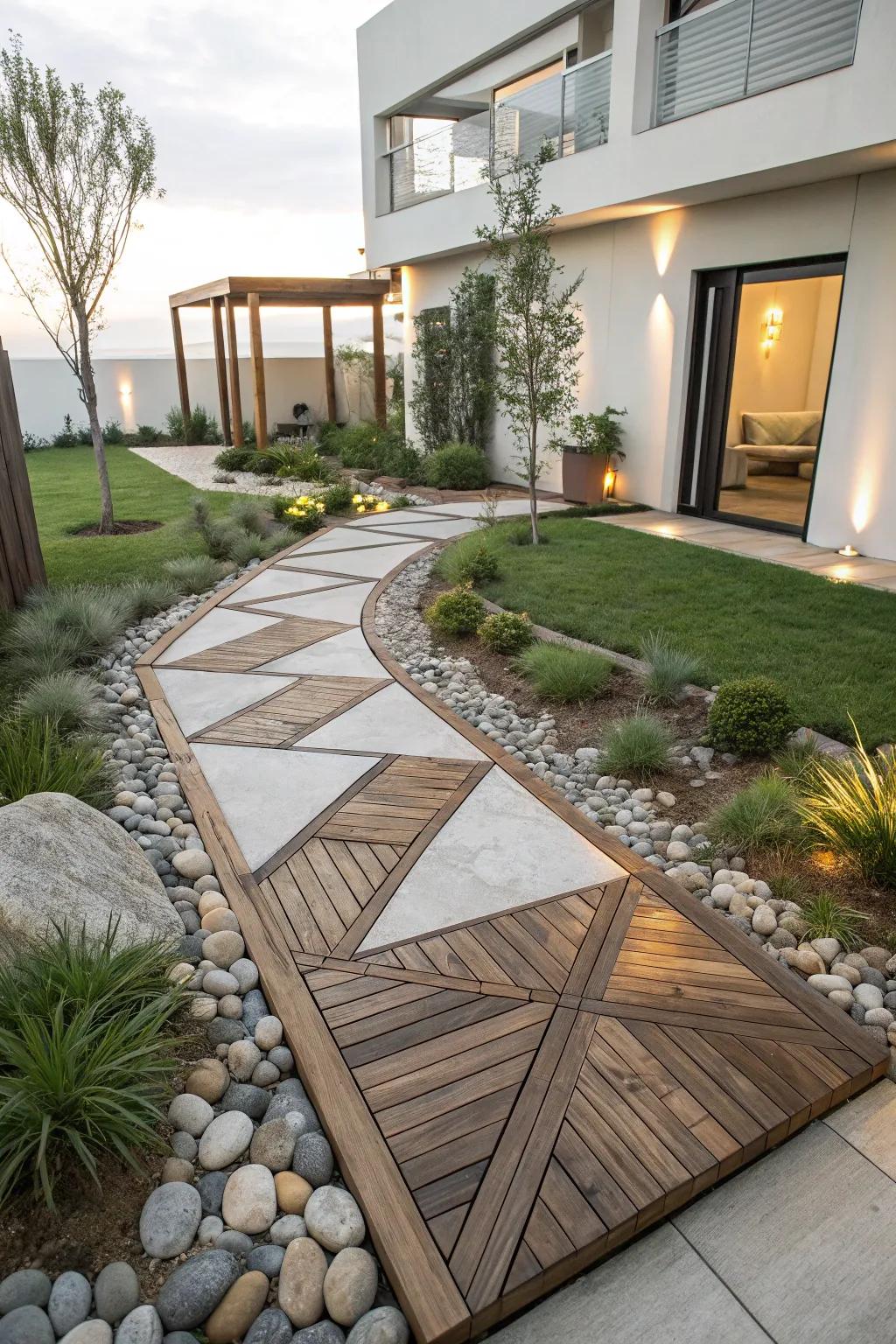
Experiment with shapes like triangles or hexagons for a geometric timber pathway. This bold choice in my garden adds a modern touch and visual intrigue.
Some ideas to consider:
- Interlocking Deck Tiles: Transform your garden path with interlocking deck tiles for a seamless geometric design.
- Outdoor Garden Pathway Lights: Enhance your timber pathway’s appeal with stylish outdoor lights for a magical evening glow.
- Wood Preservative Stain: Protect your geometric timber walkway with high-quality wood preservative stain for lasting beauty.
9. Multi-Level Deck Walkways
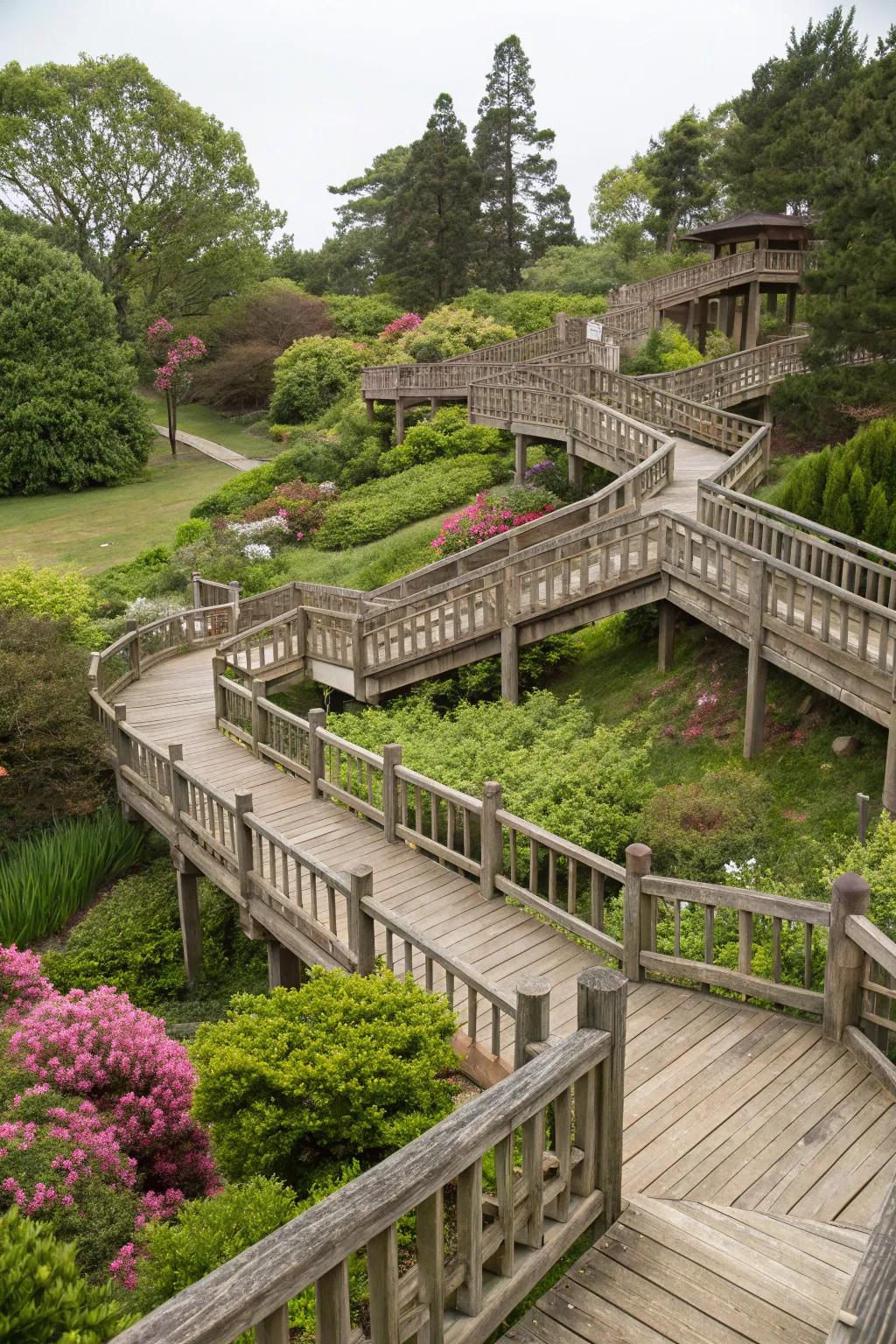
Create interest with multi-level timber walkways connecting different garden areas. This design in my sloped garden adds dimension and accessibility.
Consider these options:
- Pressure Treated Lumber: Build durable and weather-resistant pathways with pressure treated lumber for multi-level deck walkways.
- Outdoor Deck Railing Kits: Enhance safety and aesthetics with elegant outdoor deck railing kits, perfect for elevated walkways.
- Solar Pathway Lights: Illuminate your walkways with eco-friendly solar pathway lights for safety and ambiance at night.
10. Modern Aesthetics
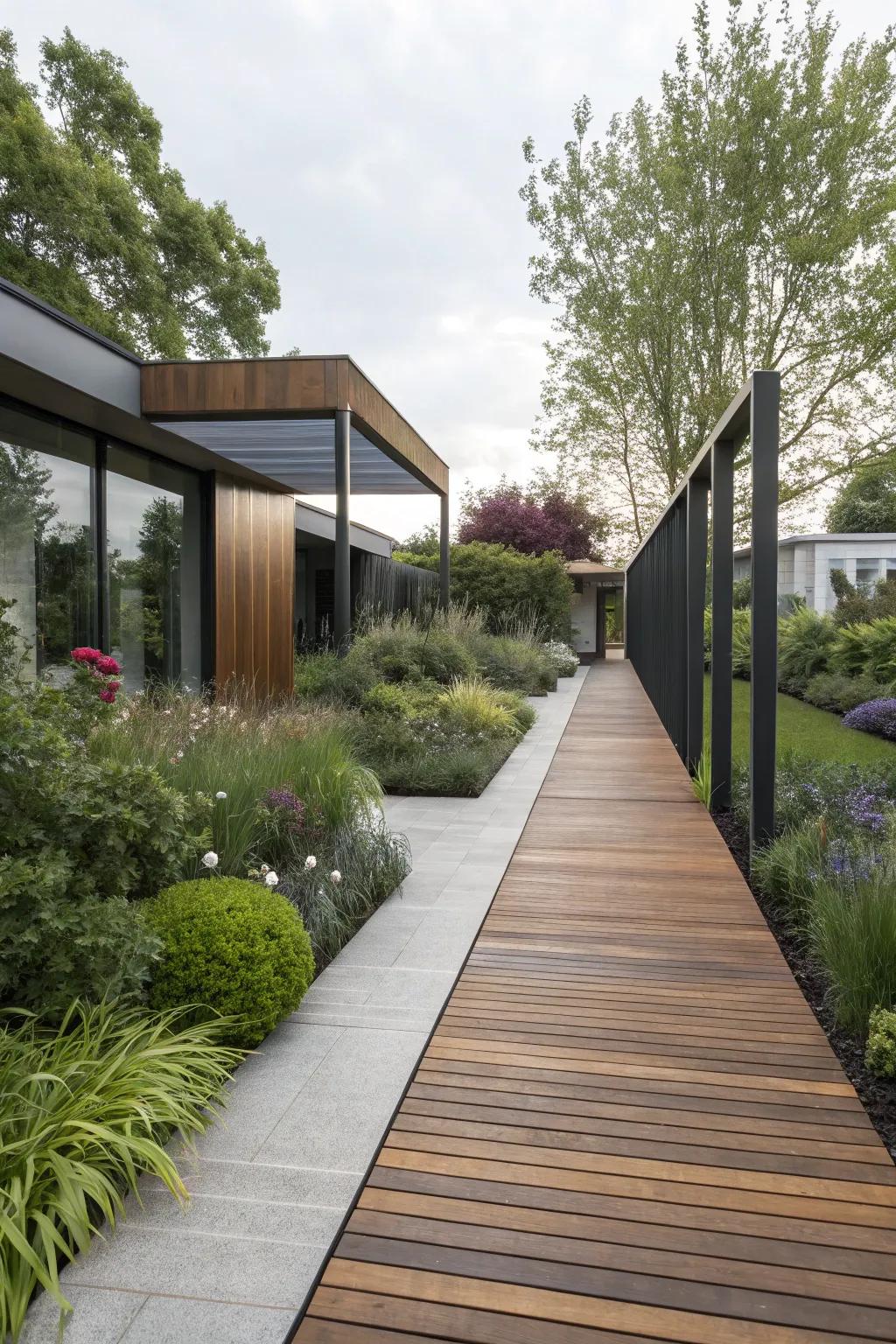
Sleek and polished timber pathways can complement contemporary garden designs. My modern garden benefits from the clean lines and minimalist appeal of this approach.
Maybe worth checking out:
- Composite Decking Boards: Upgrade your garden with durable, low-maintenance composite boards for a sleek, modern look.
- Outdoor LED Pathway Lights: Enhance your garden path with energy-efficient, stylish LED lights for a contemporary appeal.
- Garden Edging Strips: Define clean lines in your garden with flexible, easy-to-install edging for a polished finish.
11. Crosshatch Wooden Pathways

Add artistic flair with crosshatch timber pathways. In my garden, this pattern serves as a focal point, adding creativity to the landscape.
Explore these options:
- Interlocking Wood Deck Tiles: Create stunning patterns effortlessly. Enhance your garden with durable, versatile deck tiles.
- Outdoor Wood Sealant: Protect your timber pathway. Apply this sealant for lasting beauty and weather resistance.
- Wood Pathway Installation Kit: Simplify your garden project. Achieve professional results with this comprehensive installation kit.
12. Lighting Features
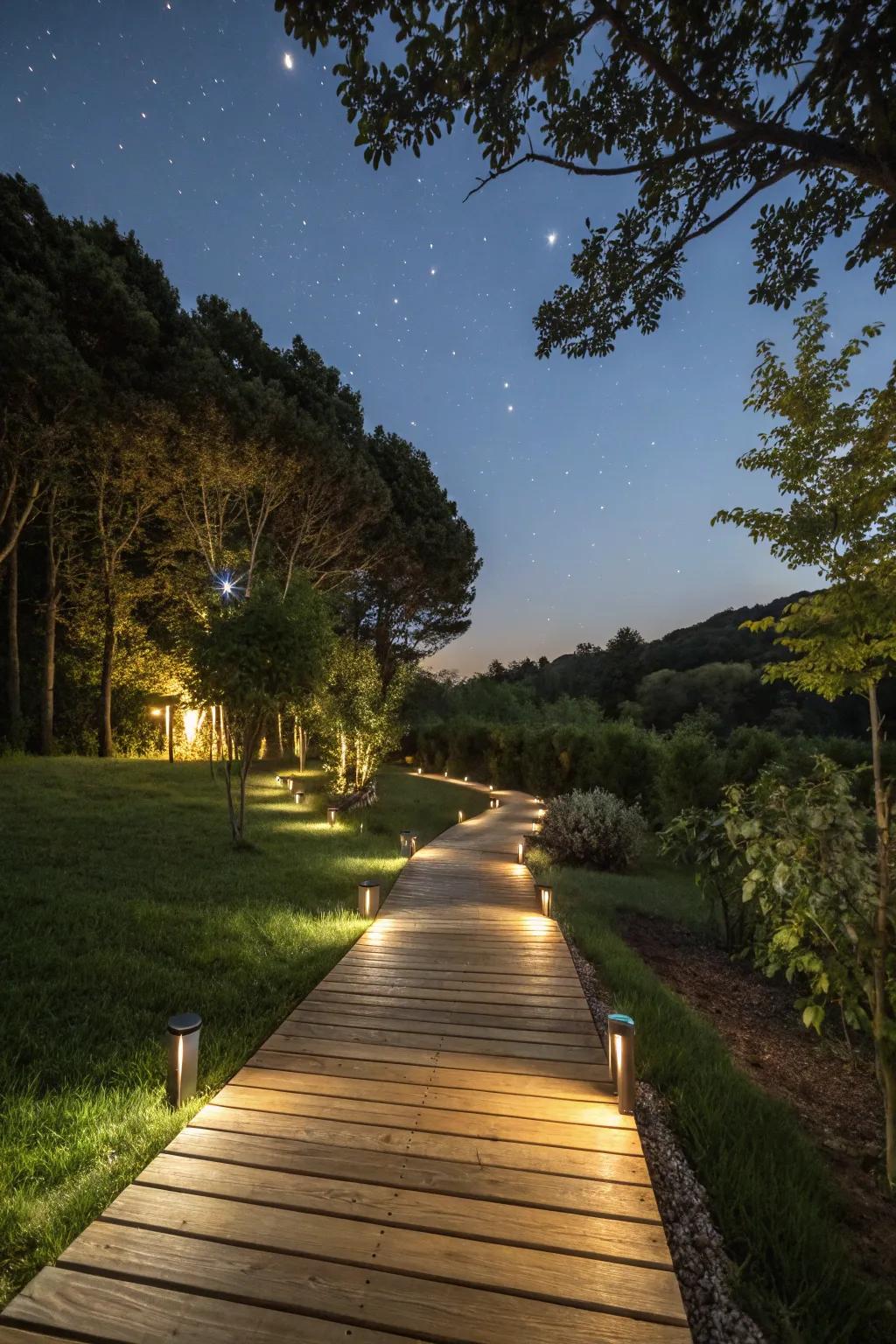
Incorporate lighting within your timber walkway for safety and aesthetics. In my garden, these lights guide the way while enhancing the nighttime beauty.
A few relevant products:
- Solar Pathway Lights: Illuminate your timber walkway effortlessly with eco-friendly, solar-powered pathway lights ensuring safety and beauty.
- LED Deck Lighting Kit: Use an LED deck lighting kit to add stylish and safe illumination to your timber walkway.
- Motion Sensor Outdoor Lights: Enhance nighttime visibility and security on your walkway with motion sensor outdoor lights.
13. Garden Pathways

Imagine a timber pathway gently curving through your garden, perfectly blending with the natural surroundings. In my own garden, this type of walkway invites exploration and offers a tranquil retreat.
Possibly handy products:
- Wooden Garden Walkway Panels: Transform your garden with eco-friendly wooden panels for a natural and serene path.
- Outdoor Pathway Lighting: Illuminate your garden paths at night with elegant and energy-efficient outdoor lighting.
- Weather-Resistant Wood Sealant: Protect your timber walkways against the elements with high-quality, weather-resistant wood sealant.
14. Wooden Slat Pathways
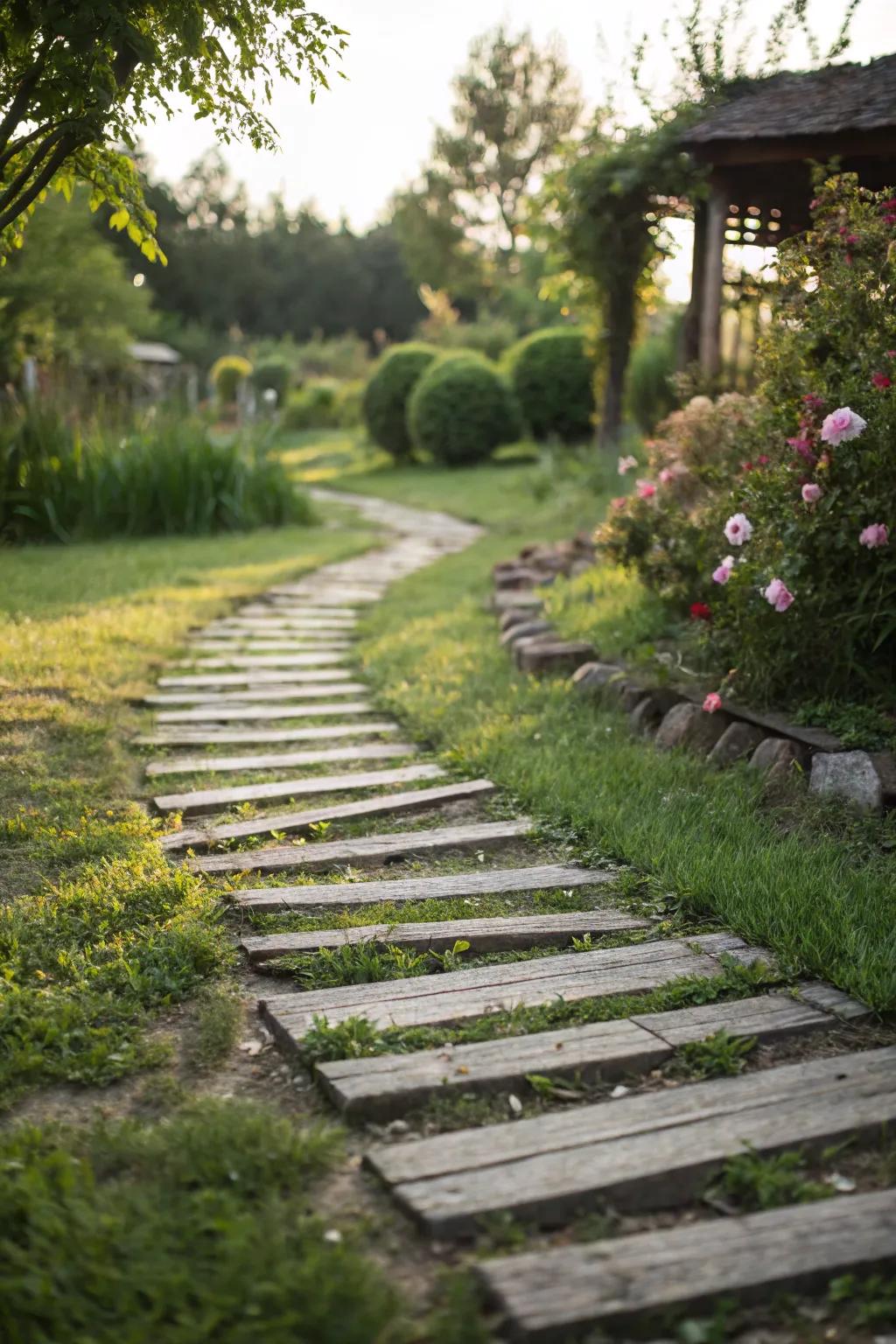
Opt for wooden slat pathways to create a light, airy feel. In my garden, the gaps between slats allow grass to peek through, adding a touch of nature.
May just do the trick:
- Weather-resistant wooden slats: Enhance your garden with these durable, weather-resistant wooden slats for a timeless look.
- Outdoor wood sealant: Protect your wooden pathways with this high-quality sealant, ensuring long-lasting durability.
- Decorative garden edging stones: Frame your wooden slat pathway with elegant garden edging stones for a polished finish.
15. Rustic Designs

For a cozy, natural feel, opt for rustic timber planks that age beautifully over time. I love how this style adds warmth and character to my garden, making it feel like a woodland retreat.
Give these a look:
- Weathered Timber Planks: Create a charming walkway with rustic timber planks that naturally weather over time.
- Outdoor Wood Stain: Preserve and enhance your timber walkway with durable, outdoor-quality wood stain.
- Non-Slip Outdoor Sealer: Ensure safety on your rustic path with an effective non-slip outdoor sealer.
16. Raised Walkways
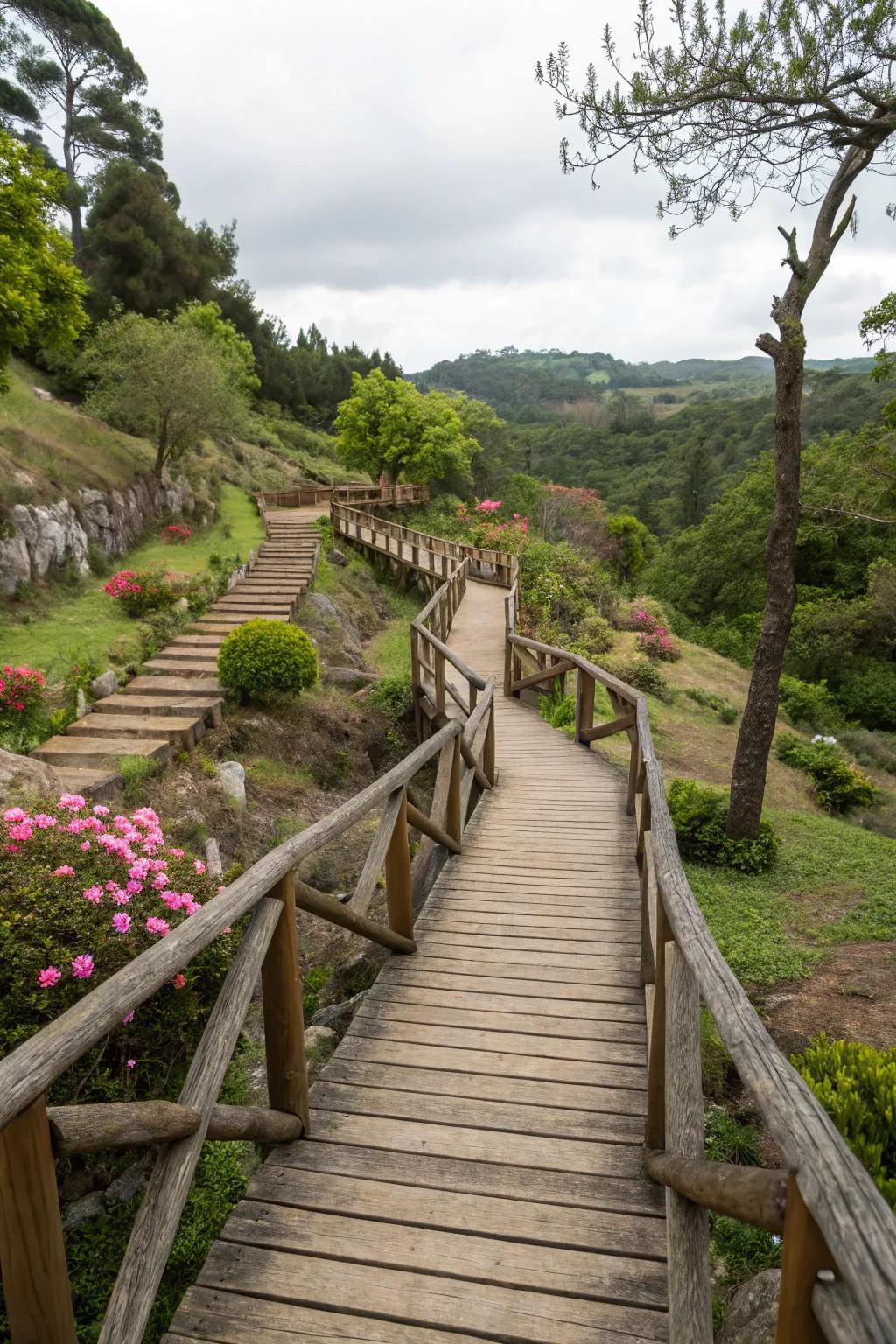
For uneven terrain, consider an elevated timber walkway that offers stunning views while maintaining a natural look. I’ve found this to be a great solution for my sloped backyard, adding both functionality and beauty.
Some handy options:
- Pressure-Treated Timber Boards: Ensure longevity and durability for your elevated walkway with high-quality, pressure-treated timber boards.
- Heavy-Duty Support Brackets: Securely anchor your raised walkway using heavy-duty support brackets for stability and safety.
- Wood Deck Stain and Sealer: Protect and enhance your wooden path with a reliable deck stain and sealer for natural beauty.
17. Pergola-Connected Pathways
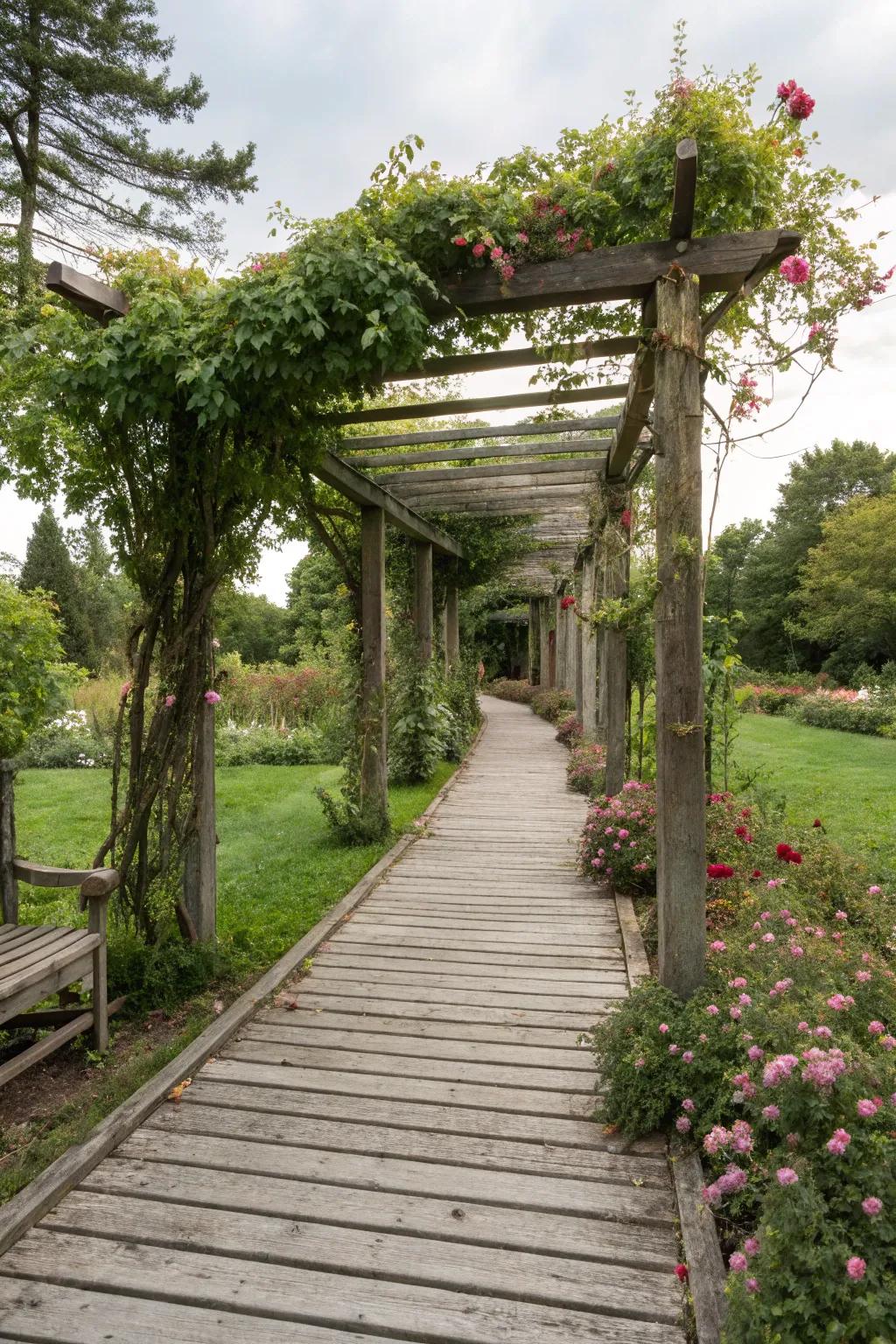
Enhance your walkway with a pergola connection for shade and beauty. In my garden, climbing plants on the pergola create a lush, inviting atmosphere.
A few choices to try:
- Wooden Pergola Kit: Enhance your garden with a pergola kit, providing shade and architectural beauty effortlessly.
- Climbing Plant Support: Encourage lush growth with sturdy plant supports perfect for climbing plants on your pergola.
- Outdoor Anchoring Kit: Ensure stability with an anchoring kit, keeping your walkway’s pergola securely grounded.
18. Wooden Boardwalks
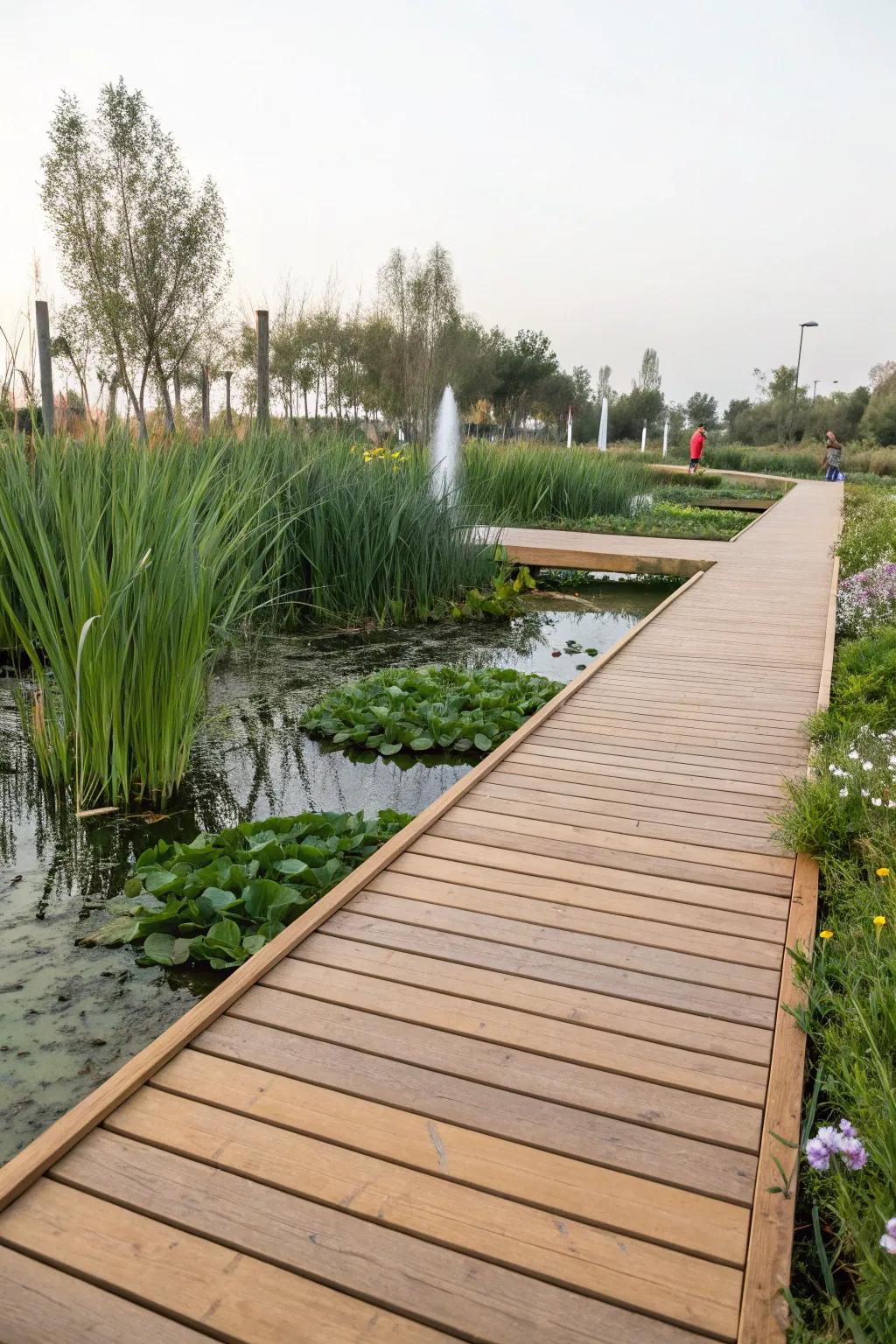
Ideal for wet areas, wooden boardwalks provide stability and charm. In my garden, they connect different spaces while maintaining an elegant aesthetic.
Check these products out:
- Pressure Treated Wood Deck Boards: Enhance your garden with durable, treated wood boards, perfect for creating elegant walkways.
- Outdoor Deck Lighting Kit: Illuminate your boardwalk with energy-efficient deck lights for a charming evening ambiance.
- Anti-Slip Decking Oil: Apply this oil to ensure safety with a slip-resistant finish on your wooden walkway.
19. Wooden Pathways with Stone Borders
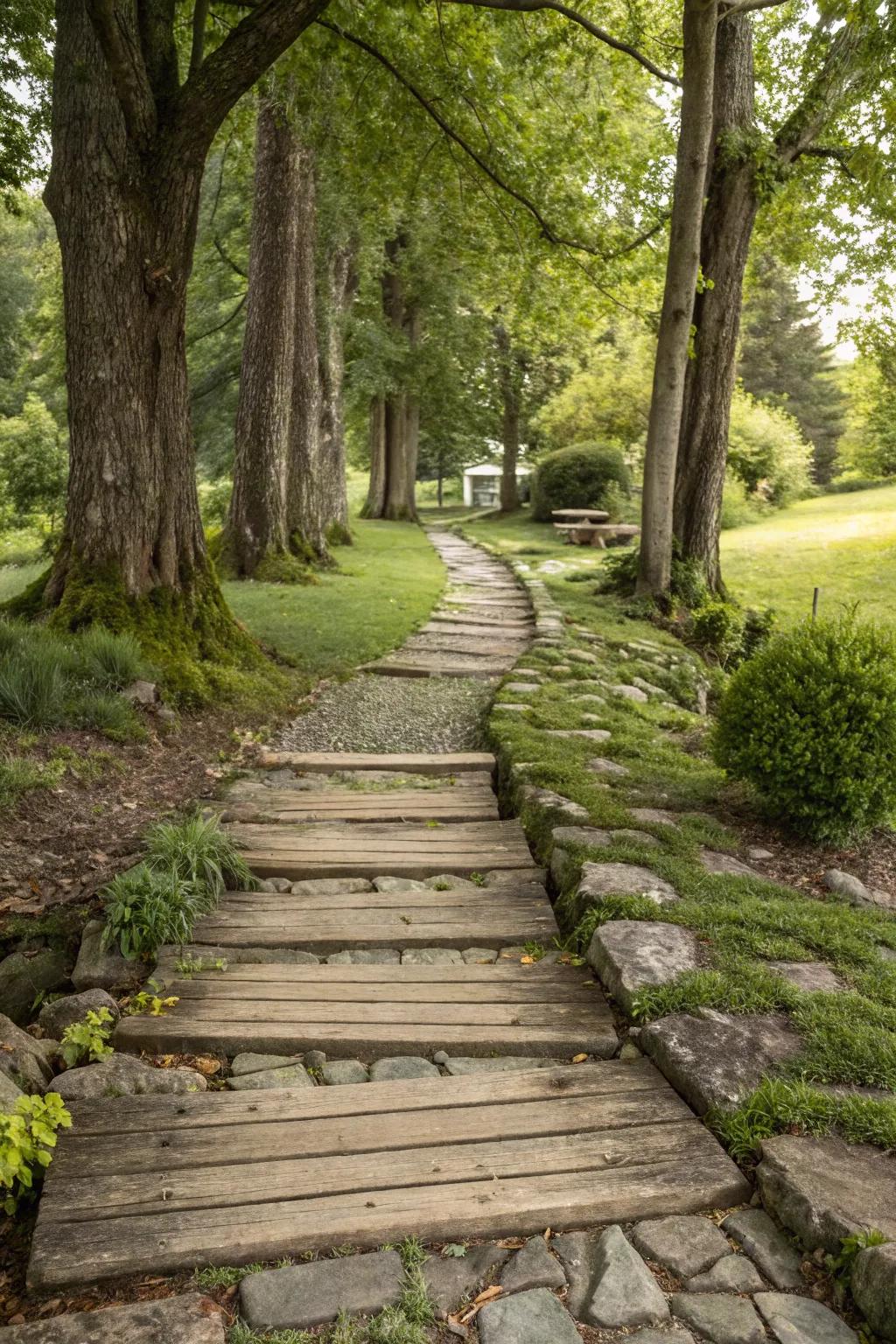
Combine wood with stone for a rustic yet refined look. In my garden, this combination defines the path and enhances the natural beauty.
You might give these a try:
- Outdoor Wooden Deck Tiles: Elevate your garden path with durable wooden deck tiles, perfect for a rustic touch.
- Garden Pathway Stone Edging Kit: Enhance your walkway with easy-to-install stone edging for a refined, natural look.
- Weather-Resistant Landscape Fabric: Protect your wooden pathway with high-quality landscape fabric for long-lasting beauty.
20. Wooden Pathways with Seasonal Decor
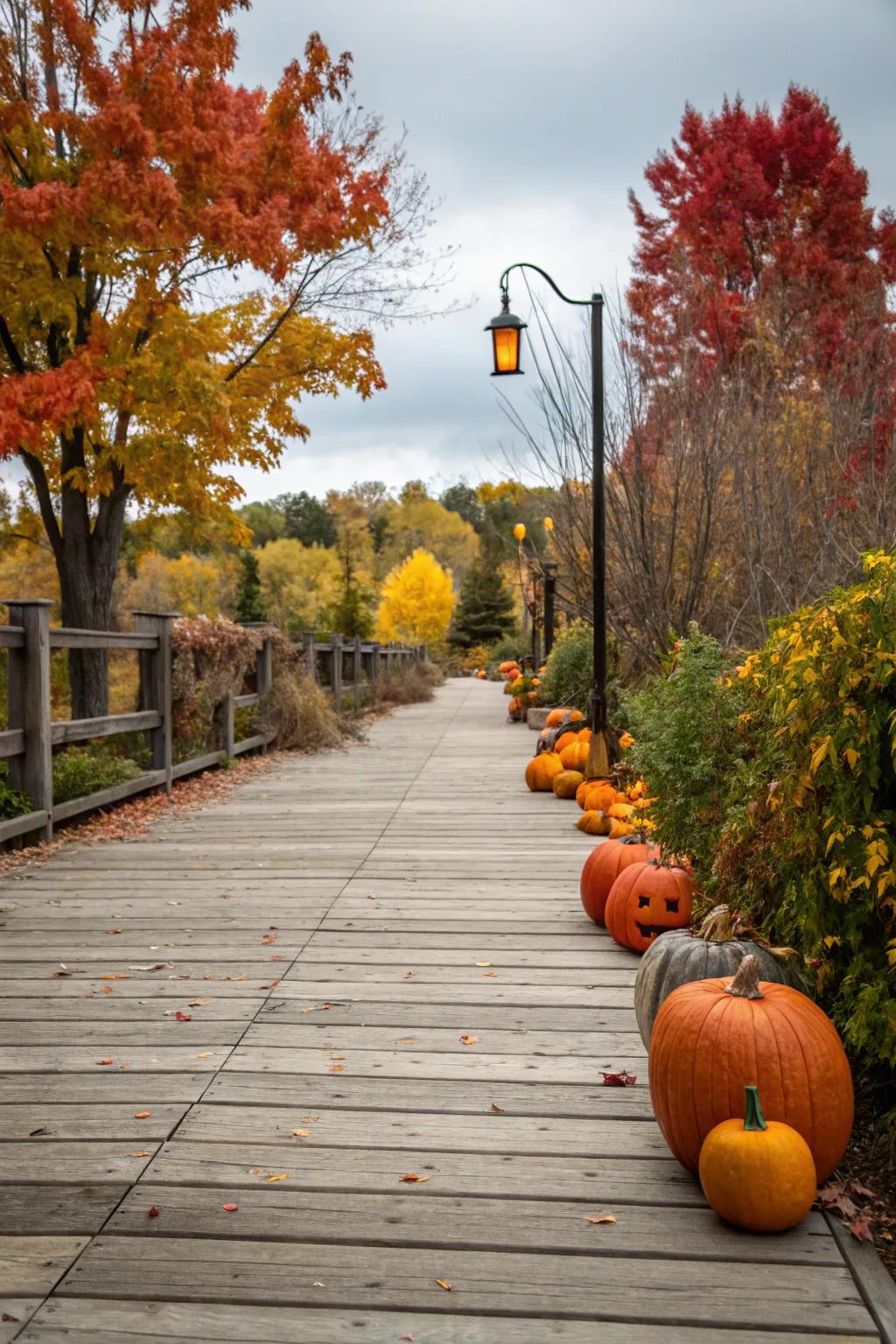
Celebrate the seasons with timber walkways adorned with festive decor. My garden features pumpkins in autumn, adding charm to the path year-round.
These products might help:
- Outdoor LED Pathway Lights: Illuminate your walkway with stylish LED lights, enhancing safety and ambiance in every season.
- Artificial Autumn Pumpkin Set: Bring autumn charm to your garden with durable, weather-resistant artificial pumpkins all season long.
- Seasonal Outdoor Garden Flags: Add a festive touch with garden flags; swap designs to celebrate each changing season.
21. Curved Wooden Bridges
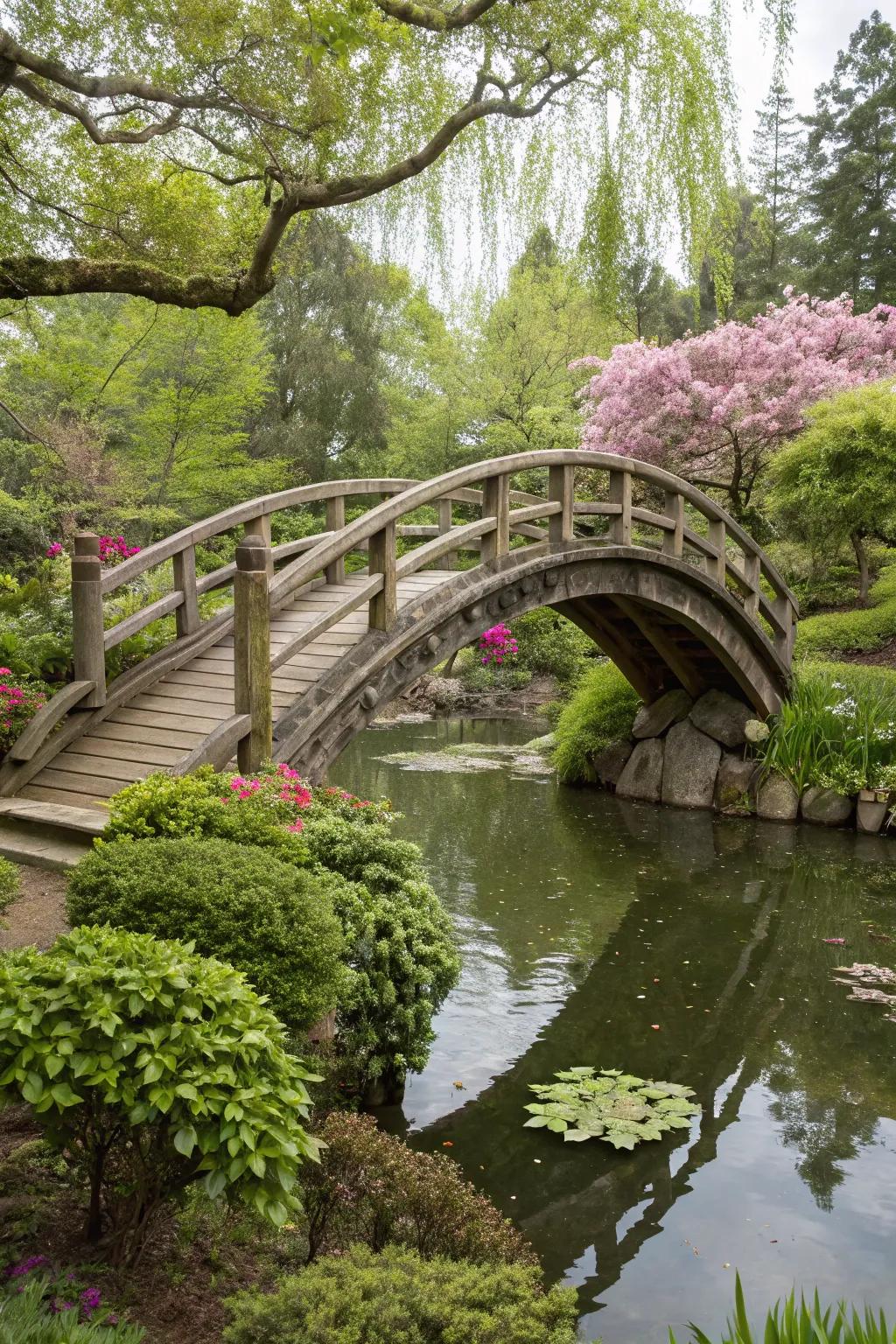
Add whimsy with a curved timber bridge over a pond or dry creek. In my garden, it serves as a charming focal point and invites exploration.
A few helpful options:
- Curved Garden Bridge Kit: Enhance your garden’s charm with an easy-to-assemble curved bridge kit, inviting exploration.
- Outdoor Wooden Arch Bridge: Add elegance to your landscape with a durable outdoor wooden arch bridge. Perfect for ponds.
- Decorative Timber Bridge: Create a striking garden focal point with a decorative timber bridge, encouraging whimsical strolls.
